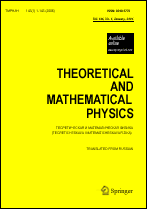|
Boundary layer collapses described by the two-dimensional intermediate long-wave equation
J. O. Olooab, V. I. Shriraa
a School of Computing and Mathematics, Keele University, Staffordshire, United Kingdom
b The Catholic University of Eastern Africa, Nairobi, Kenya
Abstract:
We study the nonlinear dynamics of localized perturbations of a confined generic boundary-layer shear flow in the framework of the essentially two-dimensional generalization of the intermediate long-wave (2d-ILW) equation. The 2d-ILW equation was originally derived to describe nonlinear evolution of boundary layer perturbations in a fluid confined between two parallel planes. The distance between the planes is characterized by a dimensionless parameter $D$. In the limits of large and small $D$, the 2d-ILW equation respectively tends to the 2d Benjamin–Ono and 2d Zakharov–Kuznetsov equations. We show that localized initial perturbations of any given shape collapse, i.e., blow up in a finite time and form a point singularity, if the Hamiltonian is negative, which occurs if the perturbation amplitude exceeds a certain threshold specific for each particular shape of the initial perturbation. For axisymmetric Gaussian and Lorentzian initial perturbations of amplitude $a$ and width $\sigma$, we derive explicit nonlinear neutral stability curves that separate the domains of perturbation collapse and decay on the plane $(a,\sigma)$ for various values of $D$. The amplitude threshold $a$ increases as $D$ and $\sigma$ decrease and tends to infinity at $D\to0$. The 2d-ILW equation also admits steady axisymmetric solitary wave solutions whose Hamiltonian is always negative; they collapse for all $D$ except $D=0$. But the equation itself has not been proved for small $D$. Direct numerical simulations of the 2d-ILW equation with Gaussian and Lorentzian initial conditions show that initial perturbations with an amplitude exceeding the found threshold collapse in a self-similar manner, while perturbations with a below-threshold amplitude decay.
Keywords:
boundary layer instability, nonlinear evolution equation, collapse,
singularity formation, laminar–turbulent transition.
Received: 17.09.2019
Revised: 04.11.2019
Citation:
J. O. Oloo, V. I. Shrira, “Boundary layer collapses described by the two-dimensional intermediate long-wave equation”, TMF, 203:1 (2020), 91–105; Theoret. and Math. Phys., 203:1 (2020), 512–523
Linking options:
https://www.mathnet.ru/eng/tmf9821https://doi.org/10.4213/tmf9821 https://www.mathnet.ru/eng/tmf/v203/i1/p91
|


| Statistics & downloads: |
| Abstract page: | 257 | | Full-text PDF : | 32 | | References: | 65 | | First page: | 10 |
|




 Contact us:
Contact us: Terms of Use
Terms of Use
 Registration to the website
Registration to the website Logotypes
Logotypes








 Citation in format
Citation in format 